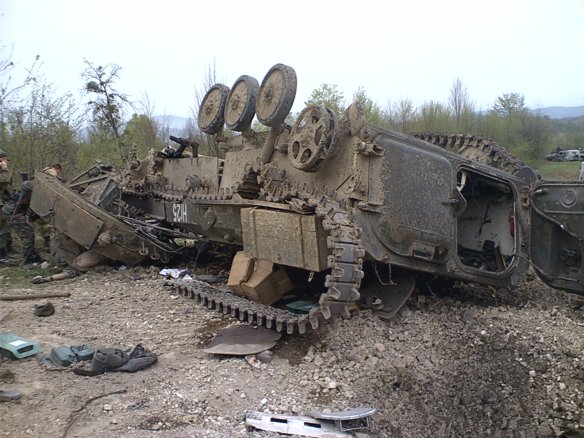The BMP-1 is a Soviet amphibious tracked infantry fighting vehicle. BMP stands for Boyevaya Mashina Pekhoty 1, meaning “infantry fighting vehicle”. The BMP-1 was the first mass-produced infantry fighting vehicle (IFV) of USSR. It was called the M-1967, BMP and BMP-76PB by NATO before its correct designation was known.
The Soviet military leadership saw any future wars as being conducted with nuclear, chemical and biological weapons and a new design combining the properties of an armored personnel carrier (APC) and a light tank like the BMP would allow infantry to operate from the relative safety of its armoured, radiation-shielded interior in contaminated areas and to fight alongside it in uncontaminated areas. It would increase infantry squad mobility, provide fire support to them, and also be able to fight alongside main battle tanks.
BMP-1 and BMP-2 series vehicles share a major drawback with many Soviet tanks. Ammunition is stored near or even inside the fighting compartment which makes them more vulnerable to a hit from an anti-tank round or a missile across the side arc. If that happens, the ammunition often explodes, killing everyone and completely destroying the vehicle. During the fighting in Afghanistan and Chechnya, hits by rocket-propelled grenades (RPGs) penetrated the BMP-1’s armor in 95% of cases. This often resulted in the vehicle burning until the ammunition exploded. Due to these limitations, Soviet/Russian soldiers customarily rode on the outside of the BMP-1, sitting on top of the hull while in combat zones.
The problem most often cited by western analysts is the design of the main fuel tank. Due to the low profile of the vehicle the designers have had to place the fuel tank between the two rows of outward-facing seats, meaning that the infantrymen sit very close to the bulk of the vehicle’s fuel storage, extra fuel is carried in the hollow armored rear doors. Therefore a hit by an armor-piercing incendiary round would set the fuel contained there (especially, if kerosene is used instead of diesel), on fire. The burning fuel would move into the crew compartment, resulting in the death or injury to the infantrymen (if they are unable to leave the vehicle via the roof hatches), and a possible explosion. However, the rear door tanks are almost always empty when the BMP goes into combat as they are only meant to increase the road travel range of the vehicle. In intense war areas where the BMP sees action often and it is relatively near to its base of operations, instructions highly recommend detaching the rear door tanks from the fuel system, filling them with sand as additional protection of the troop compartment and adding fuel to the internal main fuel tank from other sources when the need arises. This was not practiced by some crews of BMP-1s during a number of local conflicts, e.g., in Chechnya, which resulted in frequent attempts by the enemy to hit the rear doors of the BMP-1s. The inner fuel tank is more vulnerable than that of many modern IFVs – the thin side armor means that penetration is likely to occur to the inner fuel tank as well.
The BMP-1 was first tested in combat in the 1973 Yom Kippur War where it was used by Egyptian and Syrian forces. Based on lessons learned from this conflict and early experiences in the Soviet War in Afghanistan, a version with improved fighting qualities, the BMP-2 was developed. It was accepted into service in August 1980.
In 1987, the BMP-3, a radically redesigned vehicle with a completely new weapon system, entered service in limited numbers with the Soviet Army.
#
The Russian military’s conduct of the Second Chechen War learned much from the first. In the initial stages of the war, the Russian army sealed off Chechnya’s borders and concentrated on controlling the open terrain north of the Terek River, avoiding hills and built-up areas. Russian forces sought to establish secure zones governed by loyalist Chechens to demonstrate the advantages of Russian rule and win acceptance from the Chechen population. The military also did a much better job of managing the Russian media. Some key Russian journalists had been kidnapped for ransom by Chechens between the wars and no longer had much sympathy for the Chechen cause.
Tactically, the Russian approach was to use overwhelming firepower to reduce losses among Russian troops, though this naturally increased civilian casualties. Standard tactics involved using artillery (quicker to respond than aviation) to pulverize suspected Chechen strongholds before ground troops approached. This extended to the use of fuel-air explosives in built-up areas. Groznyi, which had been badly damaged during the first war, was leveled in the second. For all these improvements, the Chechen conflict is still not over. At a cost of perhaps 25,000- 30,000 Russian soldiers dead, and 100,000 or more Chechens, any stability in Chechnya under Moscow-backed Chechens is exceedingly fragile. Horrific terrorist attacks continue, within Chechnya and outside it.
This pattern can be generally applied to Putin’s presidency, and the specific case of the Russian military. Putin has brought with him the perception of decisive action, stability, and competence. The question, with regard to Chechnya, economic reform, or the Russian military, is whether that perception is matched by reality or is only a well-crafted image. As Russia’s economy is propped up by lucrative oil and gas revenues, and Russia’s independent media are gradually brought under Kremlin control, the difference between reality and illusion is increasingly difficult to determine.
